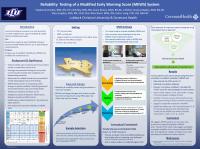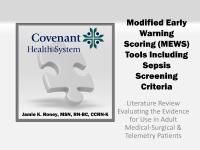| dc.contributor.author | Whitley, Erin | en |
| dc.contributor.author | Roney, Jamie K. | en |
| dc.contributor.author | Long, JoAnn D. | en |
| dc.contributor.author | Dunkle, Stephanie R. | en |
| dc.contributor.author | Maples, Jessica | en |
| dc.date.accessioned | 2016-03-17T13:02:59Z | |
| dc.date.available | 2016-03-17T13:02:59Z | |
| dc.date.issued | 2016-03-17 | |
| dc.identifier | INRS15PST126 | en |
| dc.identifier.uri | http://hdl.handle.net/10755/602061 | |
| dc.description | <p>Research Congress 2015 Theme: Question Locally, Engage Regionally, Apply Globally. Held at the Puerto Rico Convention Center.</p> | en |
| dc.description.abstract | <p>Session presented on Friday, July 24, 2015:</p>
<p><strong>Purpose:</strong> The incidence of sepsis is increasing worldwide. Early identification of sepsis is critical to patient survival. Despite advances in the identification and treatment of sepsis 35-50% of patients still die (Cildir et al., 2012). Few tools developed from sound research have been introduced to address acute declines in patient condition outside of the intensive care unit (ICU). Testing of MEWS tools has been mostly retrospective and gaps exist in data related to reliability and validity testing and outcome measurement. Septic patients may experience sudden changes in status and quickly deteriorate requiring emergent medical management or cardiopulmonary resuscitative efforts. A modified early warning scoring (MEWS) tool incorporating crucial sepsis indicators could save lives. The purpose of this project is to determine if a modified early warning scoring (MEWS) tool, adapted to include systemic inflammatory response syndrome (SIRS) criteria, can decrease mortality, length of stay, and cost to treat septic patients.</p>
<p><strong>Methods:</strong> This study will use a comparative descriptive design. The charts of all patients diagnosed with sepsis will be evaluated during the six-month period from January 2014 to July 2014 prior to implementation of a MEWS tool with SIRS criteria and the charts of all patients diagnosed with sepsis from August 2014 to January 2015 after implementation of a MEWS tool with SIRS criteria will be evaluated. The research questions for this study are: 1) Is there a difference in mortality in sepsis patients scored using a MEWS tool as compared to sepsis patients who did not use the MEWS assessment tool? 2) Is there a difference in length of stay for septic patients post MEWS implementation? 3) Does use of MEWS tool decrease cost to treat septic patients? Descriptive statistics will be collected and reported on the mortality rates, length of stay, and cost to treat in both groups. A Chi-square test, alpha 0.05, will be used to determine if a proportional difference exists between the groups for each of the study variables.</p>
<p><strong>Results:</strong> Data collection for this project is in progress.</p>
<p><strong>Conclusion:</strong> Early warning systems facilitate identification of all at-risk patients. Nurses accurately identifying and regularly assessing patient vital signs, laboratory data, and other physiological findings are essential to a successful sepsis recognition tool. The researcher expects to find a MEWS tool which incorporates SIRS criteria will be effective in identifying adult hospitalized patients at-risk for clinical decline from sepsis and will decrease mortality, length of stay, and cost to treat.</p> | en |
| dc.format | Text-based Document | en |
| dc.language.iso | en | en |
| dc.subject | Sepsis | en |
| dc.subject | Systemic Inflammatory Response Syndrome | en |
| dc.subject | Modified Early Warning Score | en |
| dc.title | Recognizing sepsis using a modified early warning scoring (MEWS) tool | en |
| dc.type | Poster | en |
| dc.rights.holder | <p>
All rights reserved by the author(s) and/or publisher(s) listed in this item record unless relinquished in whole or part by a rights notation or a Creative Commons License present in this item record.
</p><p>
All permission requests should be directed accordingly and not to the Sigma Repository.
</p><p>
All submitting authors or publishers have affirmed that when using material in their work where they do not own copyright, they have obtained permission of the copyright holder prior to submission and the rights holder has been acknowledged as necessary.
</p> | en |
| dc.description.note | <p>Items submitted to a conference/event were evaluated/peer-reviewed at the time of abstract submission to the event. No other peer-review was provided prior to submission to the Henderson Repository.</p> | en |
| dc.type.category | Full-text | en |
| dc.evidence.level | N/A | en |
| dc.research.approach | N/A | en |
| dc.subject.cinahl | Systemic Inflammatory Response Syndrome--Diagnosis | en |
| dc.subject.cinahl | Sepsis--Diagnosis | en |
| dc.subject.cinahl | Sepsis | en |
| dc.subject.cinahl | Severity of Illness Indices | en |
| dc.contributor.department | Iota Mu | en |
| dc.author.details | Erin Whitley, RN; Jamie K. Roney, RN-C, CCRN; JoAnn D. Long, RN, NEA-BC; Stephanie R. Dunkle, RN; Jessica Maples, RN-C | en |
| dc.conference.name | 26th international Nursing Research Congress | en |
| dc.conference.host | Sigma Theta Tau International | en |
| dc.conference.location | San Juan, Puerto Rico | en |
| dc.date.conferenceyear | 2015 | |
| dc.description.reviewtype | Abstract Review Only: Reviewed by Event Host | en |
| dc.description.acquisition | Proxy-submission | en |





